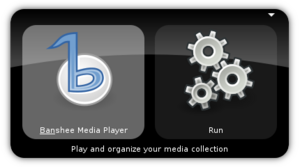Software:GNOME Do
 | |
 GNOME Do in action (Classic interface shown) | |
| Original author(s) | David Siegel |
|---|---|
| Stable release | 0.95.3 (November 12, 2014) [±] |
| Written in | C# |
| Operating system | Linux |
| Platform | GNOME, Mono |
| Type |
|
| License | GNU GPL |
| Website | do |
GNOME Do (often referred to as Do) is a free and open-source application launcher for Linux originally created by David Siegel,[1] and currently maintained by Alex Launi. Like other application launchers, it allows searching for applications and files, but it also allows specifying actions to perform on search results. GNOME Do allows for quick finding of miscellaneous artifacts of GNOME environment (applications, Evolution and Pidgin contacts, Firefox bookmarks, Rhythmbox artists and albums, and so on) and execute the basic actions on them (launch, open, email, chat, play, etc.).[2]
While it is designed primarily for the GNOME desktop, it works in other desktop environments, such as KDE.
GNOME Do was inspired by Quicksilver for Mac OS X, and GNOME Launch Box.[3]
Docky
Docky is a theme for GNOME Do that behaves much like the Mac OS X dock.[4] Unlike GNOME Do's traditional interface, Docky can be set to one of three modes for hiding:
- None - Docky is always visible.
- Autohide - Docky is normally hidden, and appears when the mouse pointer reaches Docky's (unseen) edge at the lower/upper edge of the screen.
- Intellihide - Docky hides if it overlaps any window in the active window group, but it can still be brought up with the mouse pointer as described above.
Standard Do functionality is still present within Docky, and the Do hot-key will still produce the expected behavior.
Docky 2[5][6][7][8] is a separate application from GNOME Do. Integration with GNOME Do is planned for Docky 2.[9]
See also
- Comparison of applications launchers
- List of dock applications
- GNOME
- Mono
References
- ↑ Lifehacker - Fast File and Program Launching with GNOME Do
- ↑ Ubuntu 10.04 Add/Remove Applications description for GNOME Do
- ↑ GNOME Do Developers. "GNOME + Do = Crazy Delicious". http://do.cooperteam.net/.
- ↑ "GNOME Do - Release". http://do.cooperteam.net/release.shtml.
- ↑ "Welcome to the Docky wiki". http://wiki.go-docky.com/index.php?title=Main_Page.
- ↑ "Docky in Launchpad". https://launchpad.net/docky.
- ↑ "Docky Separates from GNOME Do, Still a Clever Linux App Dock". 2009-11-23. http://lifehacker.com/5411278/docky-separates-from-gnome-do-still-a-clever-linux-app-dock.
- ↑ "Gnome-Do Docky To Become Separate Application". 2009-10-15. http://www.omgubuntu.co.uk/2009/10/gnome-do-docky-no-longer-part-of-gnome.html.
- ↑ Omgubuntu.co.uk
Further reading
- Nathan Willis (January 11, 2008) Find the items you want with GNOME Do, Linux.com
- Daniel Pop-Silaghi (28 February 2009) GNOME Do: The King of Launchers, Softpedia Application of the month
- Kevin Purdy (Feb 3, 2009) GNOME Do's Smart Dock Takes App Launching to Another Level, Lifehacker
External links
- GNOME Do at Launchpad
- GNOME Do: an Ontology-Informed, Search-DrivenCommand Interface for the GNU/Linux Desktop
- GNOME Do – Launcher tool to search and launch applications files and more, susegeek.com
 |



